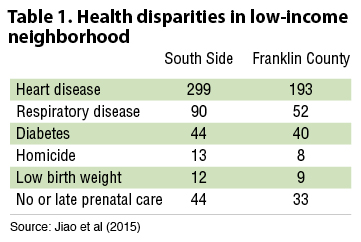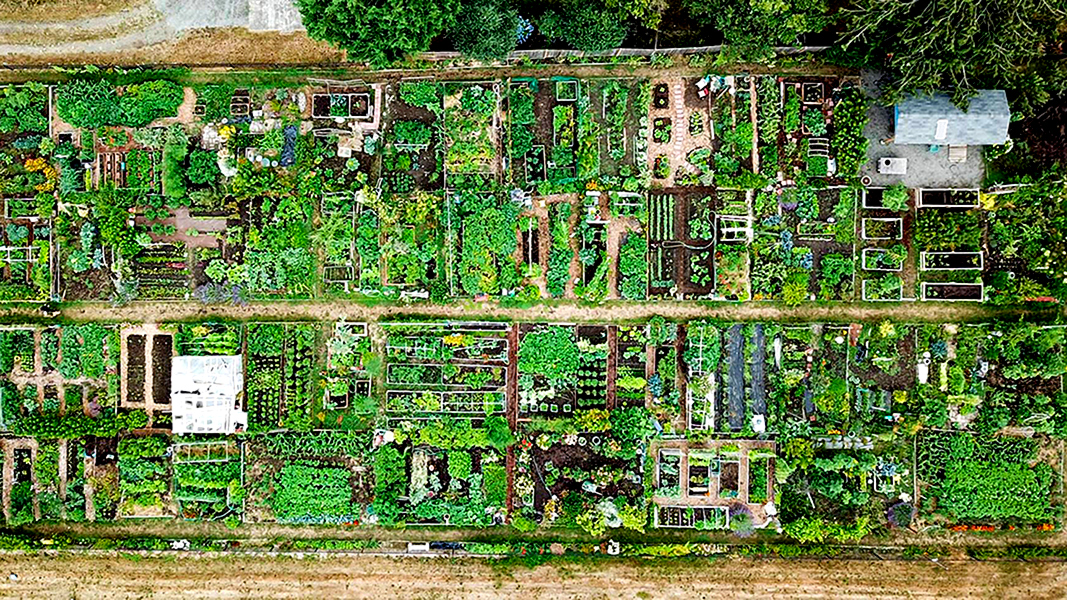Top: Aerial photo of Harvest Pierce County community garden plots. Photos courtesy Harvest Pierce County
 Sally Brown
Sally Brown
Environmental Justice (EJ) is a real thing. No argument on that one. The questions are where do you start and how do you right decades/centuries of wrongs? Here in the Pacific Northwest we like to delude ourselves into thinking that we are all very politically correct as we drink our lattes and tend to our native plant-filled gardens. Environmental justice was a somewhere else topic as we have all bent over backwards (possibly due to decades of practicing yoga) to be fair and just. At least that is what everyone thought until two publications by a professor at the University of Washington Bothell hit the streets (Malone et al, 2022; Malone et al, 2023). Dr. Melanie Malone studied soils and crops in community gardens in Seattle and concluded that the sites were contaminated, the produce was contaminated and that this was an example of environmental injustice. From a science perspective, there are several issues that I have with the papers. However, they raise an important issue, one in which organics play a role. Let’s use that enhanced flexibility from all that yoga to dive deep.
Malone was focused on soil contamination, but the issues related to environmental justice (EJ) go beyond what is in the dirt. Another paper I read on the topic used the term ‘exposome’ meaning the lifetime exposure to a range of contaminants that likely factor into health disparities. Jiao et al (2015) also explained that the issue of environmental contaminants must be considered in the context of social factors that impact health. These factors include economic stability; education; health and healthcare; neighborhood and built environment; and social and community context.
 The authors looked at soils in a low-income neighborhood in Columbus, Ohio. They also presented some data on health disparities between the low-income neighborhood and the county in general. Take a look at the South Side neighborhood in comparison to Franklin County as a whole in Table 1. There is definitely a difference and not a good one.
The authors looked at soils in a low-income neighborhood in Columbus, Ohio. They also presented some data on health disparities between the low-income neighborhood and the county in general. Take a look at the South Side neighborhood in comparison to Franklin County as a whole in Table 1. There is definitely a difference and not a good one.
To Plant Or Not To Plant, That Is The Debate
In Seattle, a vacant lot is a town home or apartment building waiting to happen. In much of the country, vacant lots are signs of urbanization past its prime. These are the lots that can easily be turned into gardens or green space. These are also lots where levels of soil contamination are likely well beyond background. If you read the Malone papers and others in the literature, the suggestion is to leave the lots alone. Any contact with that soil, the reasoning is, would just make matters worse. I disagree, and so does Michelle Kondo.
Michelle is with the US Forest Service in Philadelphia. I knew her back in the day when she was drinking lattes and swimming several lanes over (faster) from me in Seattle. She has published a number of studies lately looking at the impact of leaving the lots vacant versus taking care of them. Turning the lots green helps to alleviate many of the wrongs that have historically been wrought. In one study, she and her coauthors looked at the broad range of literature and found that green space in urban areas reduced mortality, heart rate and violence. It increased mood, physical activity, and attention (Kondo et al., 2018). In a later paper, Kondo saw that increased tree cover was associated with improved mental health and that planting trees “was associated with a significant narrowing of income-based inequalities in the prevalence of mental health conditions.” In other words, trees help fix environmental injustices. In another study, she looked at the impact of turning empty neglected lots green on crime (Sadatsafavi et al., 2022). Taking care of these lots, meaning planting and tending rather than simply mowing, reduced crime in the areas around the lots.
Using those lots to grow food yields additional benefits. You have transformed a derelict lot into an active meeting space where neighbors can work together, share information and seeds. You have increased access to fresh fruits and vegetables. And there are the benefits associated with the increased physical activity required to dig the dirt. In other words, we have a conundrum. Do the risks of contaminants in the soil outweigh the potential benefits of reclaiming and using the land?
What Are The Contaminants?

In much of the country, vacant lots are signs of urbanization past its prime. These are the lots that can easily be turned into gardens or green space.
To answer that requires a detour into what the likely contaminants are, what levels are dangerous and how realistic is the threat that they pose. The contaminants in urban soils run the gamut from polyaromatic hydrocarbons (PAHs) to pieces of glass. Right smack in the middle of the two is lead (Pb), primarily a result of the decades of of using leaded paint and gasoline. Lead in urban soil is perhaps as common as broken bottles. The hazards associated with broken glass are immediately clear — cuts and infections. Both nasty, both easily fixed. Get your tetanus shot before you work in dirt! With all other contaminants, the concern is not with immediate harm. It is with harm over time or what is referred to as chronic toxicity.
Chronic toxicity occurs over time from exposure at levels well below what can kill you outright. This fits into the whole notion of the exposome that this column started with. When considering chronic toxicity, you have to look at how the contaminant can get from the soil to the person and to the part of the person where it can do harm. I recently reviewed the literature on this topic for both PAHs and Pb.
Polyaromatic hydrocarbons are a broad group of carbon-based compounds. What PAHs have in common is that they have two or more benzene rings — a carbon structure with 6 carbons and 6 hydrogen atoms. Some of these can cause cancer. The big bad boy of the bunch is benzo[a]pyrene. Sixteen members in this class of compounds are considered hazardous and are often ranked or described as the B(a)P equivalents. In other words, their hazard ranking is compared with benzo[a]pyrene. They are listed as some of EPA’s priority pollutants. Soil concentrations of PAHs are often reported as B(a)P equivalents. Many of the PAHs in soils come from incomplete combustion of fossil fuels. They are also formed when you burn steak on the grill, burn coal in a power plant or burn trees in a forest fire. In cities, the major source of PAHs is the burning of fossil fuels in cars, trucks, and furnaces.
Transmission Pathways
Having PAHs and Pb contaminants in the soil is bad in principle. It is only bad in the real world if those contaminants somehow migrate from the dirt into people. Different contaminants have different ways of doing that. Here is a basic list of pathways — the equivalent of Google maps for soil contaminants:
- Inhalation
- Dermal contact
- Ingestion: Eating soil — typically transmitted when eating not well washed plants grown in the soil or crops grown in the soil that absorb the contaminant
The inhalation pathway is bad for both PAHs and Pb. Dust particles are easy to breathe in and getting the contaminants into your lungs is a pretty effective way to have them enter your body. If you are worried about contaminants in soils in derelict lots, getting stuff to grow on those soils is a sure-fire way to reduce the potential for wind-blown dust. Plants do an excellent job of holding soil in place. With that said, dust can be a concern even in well-tended gardens. If you dig in the soil, you may end up with dirt on your shoes. Tracking that into the house can result in dust in the home that carries the soil contaminants with it.
Dermal contact is a potential concern for PAHs and not one for Pb. There is a potential for the PAHs in the soil to make their way through your skin. Will this happen and if the answer is yes, will it happen enough to make a difference? With chronic toxicity as opposed to acute toxicity, that exposure has to happen often enough and with enough adsorption to make a difference. That is really difficult to measure. One study tested PAH-contaminated soils using some version of lab skin and did not see any adsorption (Hettairachchi et al., 2016). The PAHs in the soils that they tested were between 23 and 50 ppm.
For both PAHs and Pb, direct soil ingestion — aka eating dirt — is the primary risk associated with contaminated soils (Ruby et al., 2016). Most of the studies on ingestion are focused on little kids eating dirt. This is for two reasons: little kids are more likely to eat dirt than older kids and adults and little kids (particularly for Pb) end up absorbing more of what they eat. While contaminated soil likely tastes the same as clean soil (clean dirt—is that an oxymoron?), it is not the flavor we are concerned about.

Using vacant lots to grow food transforms a derelict lot into an active meeting space where families and neighbors can work together, share information and seeds.
The danger depends on how much of what is eaten is actually absorbed. If that isn’t clear, think of what dog poop looks like after Fido has found the Crayolas. PAHs are carbon based, not highly water soluble and so likely to stick to soil organic matter. If they are stuck, they are less likely to come off those particles even when they are in your gut. The percent of total Pb absorbed also varies (Ryan et al., 2004). Here it is the mineral form of Pb that makes the difference.
People also talk about exposure to Pb and PAHs both in and on plants from the garden. Small particles of soil can stick to plants so a good washing is always a smart thing prior to snacking — here I am talking about both hands and plants. Plants can also take up both PAHs and Pb. We are really good at detecting both in miniscule quantities. The concentration of the contaminant in the plant in relation to the soil is referred to as the Bioaccumulation Factor (BAF). If it is less than 1, the world is a much better place. For both of these contaminants, the BAF is typically several orders of magnitude less than one. In addition, when you eat contaminants in your food, the percent that is actually absorbed into your body goes way down.
Sally Brown, BioCycle Senior Adviser, is a Research Professor at the University of Washington in the College of the Environment. Part II of this Connections’ series examines what contaminant level measurements mean, and how best to treat/remediate the soil.













